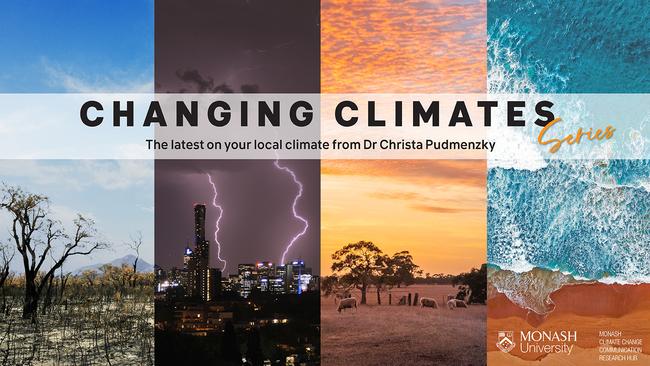Fighting climate change in style
Dr Christa Pudmenzky takes a look at the environmental impact of fashion and explores opportunities to sew a sustainable future.

Hyperlocal
Don't miss out on the headlines from Hyperlocal. Followed categories will be added to My News.
Whether you love to wear a gown with stilettos, a t-shirt and trackies, or a pair of brightly coloured sports tights, fashion is all around us.
For many, fashion is an outlet for personal expression and identity, reflecting who we are, what we stand for and how we want to be perceived by the world.
In 2021, Australia's combined fashion and textile industry contributed $27.2 billion to our economy, and generated $7.2 billion in export revenue.
The industry also employs almost half a million people, 77 per cent of whom are women.
Unfortunately, the environmental cost of our clothes is adding up.
A Barbie girl in a warming world
Just eight supply chains are responsible for over half of the entire world's greenhouse gas emissions, and fashion sits at number three.
The industry generates around 2.1 billion tonnes of emissions every year.
And, around two thirds of these emissions are produced before the fabric even hits the sewing machine – predominantly from the production and transportation of the raw materials.
The consequence of this is an increasingly changing climate.
In Australia, we're seeing temperatures rise including in Rockhampton.
Here, the average winter overnight temperature now sits at 12C – that's 2.4C warmer than in the early 1970s.

The environmental impact doesn't end here.
Fashion is plastic, it's not fantastic
Let's dig a little deeper by taking a look at our fashion icon and recent movie star, Barbie, wearing a cropped polyester shirt and a washed out pair of denim jeans.

Starting at the top, polyester is a type of plastic, typically made from crude oil.
Like other plastic objects, our polyester clothes aren't biodegradable and can shed harmful microplastics when we wear and wash them.
They also have a large carbon footprint, with around 5.5kg of emissions produced per polyester shirt – about twice that of their cotton counterpart.
Despite this, synthetic fabrics like polyester, nylon and acrylic have flooded our retail market with over half the clothing Aussies bought during 2018-19 made from polyester alone.
Moving on down, Barbie's denim jeans are made from cotton.
Natural fibres like cotton, wool and silk have markedly lower emissions than their synthetic sisters.
However, producing natural fibres is highly resource intensive.
Cotton for example requires large amounts of land, fertiliser and pesticide to grow.
It is also a very thirsty crop, taking almost 4000L of water to make every pair – that's enough drinking water to last a person five years.
The impact of both synthetic and natural fabrics is compounded by our need to buy the latest fashion staple.
In fact, Aussies buy around 56 new items of clothing a year, and more than 220,000 tonnes of our 'precious' garments end up in landfill.
Shifting style
You've probably heard the term 'sustainable fashion' but what does it actually mean?
Put simply, it is fashion designed, produced, distributed, and consumed in an environmentally friendly and ethical way.
We're already starting to see green initiatives from clothing brand operations across the country.
In 2021 for example, the Australian Fashion Council partnered with organisations and universities to create the National Clothing Product Stewardship Scheme, due to launch in July next year.
The government-funded initiative aims to improve the design, reuse and recycling of our clothing and enable Australia to achieve a net zero fashion and textile industry by 2050.
Individual companies like NAGNATA are also starting to shift their fashion cycles, working by the mantra 'movements not seasons'.
This allows a slow release of collections that build upon and complement each other, rather than fast fashion which rapidly cycles – about 52 times a year – through a variety of clashing styles.
Greening up our wardrobes
As individuals, the best thing we can do is put down our credit cards and push back against our shopping temptations.
A great way to do this is by tapping into your inner tailor and repairing well-worn clothing to ensure your favourite pieces grow old with you.
Alternatively, pick up some pre-loved attire from an op shop – you're almost guaranteed a bargain.
We can also limit consumption of new clothing by embracing the idea of a capsule wardrobe that allows you to have lots of stylish outfits made from just a few interchangeable pieces.
And, lucky for you, Australia is teeming with high quality, sustainable brands who focus on limiting emissions and recycling materials.
Supporting these climate-conscious companies – who often make clothing from natural, eco-friendly fabrics like hemp and bamboo – will help keep your wardrobe eco-friendly and long-lasting.
Together, these changes will help us and Barbie stay green on the runway and limit the impacts of climate change.
Want more information on how your climate is changing? Check out the last article in this series.
Dr Christa Pudmenzky is a climate scientist at the University of Southern Queensland.
This column is part of a collaboration between Monash University and News Corp to deliver hyperlocal weather and climate information.

